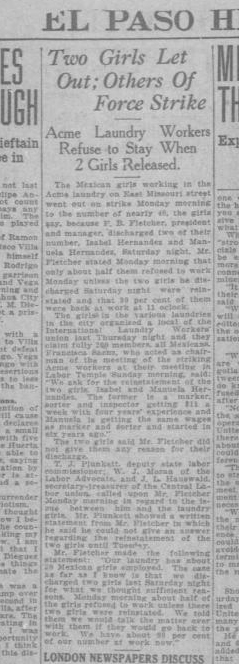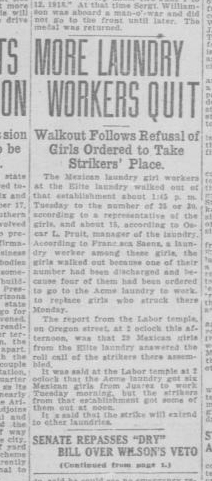Document Text |
Summary |
| Two Girls Let Out; Others of Force Strike Acme Laundry Workers Refuse to Stay When 2 Girls Released. |
Two Acme Laundry workers were fired. Other workers went on strike in response. |
| The Mexican girls working in the Acme laundry on East Missouri street went out on strike Monday morning to the number of nearly 40, the girls say, because F. B. Fletcher, president and manager, discharged two of their number, Isabel Hernandez and Manuela Hernandez, Saturday night. | Almost 40 Mexican laundry workers went on strike after two of their co-workers were fired. |
| Mr. Fletcher stated Monday morning that only about half of them refused to work Monday unless the two girls he discharged Saturday night were reinstated and that 90 per cent of them were back at work at 11 oclock. | The owner of the laundry claimed almost all of the strikers went back to work the same day. |
| The girls in the various laundries in the city organized a local of the International Laundry Workers’ union last Thursday night and they claim fully 200 members, all Mexicans. Francisca Saenz, who acted as chairman of the meeting of the striking Acme workers at their meeting in Labor Temple Sunday morning, said: “We ask for the reinstatement of the two girls, Isabel and Manuela Hernandez. The former is a marker, sorter, and inspector getting $11 a week with four years’ experience and Manuela is getting the same wages as a marker and sorter and started in six years ago.” | The Thursday before the strike, 200 laundry workers organized a union. Their leader spoke about the strike and said they demand the laundry rehire the two workers they fired. |
| The two girls said Mr. Fletcher did not give them any reason for their discharge. | The two workers say they were not told why they were fired. |
| J. Plunkett, deputy state labor commissioner; W. J. Morgan of the Labor Advocate, and J. L. Hauswald, secretary-treasurer of the Central Labor union, called upon Mr. Fletcher Monday morning in regard to the issue between him and the laundry girls. Mr. Plunkett showed a written statement from Mr. Fletcher in which he said he could not give an answer regarding the reinstatement of the two girls until Tuesday. | Male officials from the state and labor movement met with the laundry owner to discuss the strike. |
| Mr. Fletcher made the following statement: “Our laundry has about 30 Mexican girls employed. The case as far as I know is that we discharged two girls last Saturday night for what we thought sufficient reasons. Monday morning about half of the girls refused to work unless there two girls were reinstated. We told them we would talk the matter over with them if they would go back to work. We have about 90 per cent of our number at work now.” | The laundry released a statement saying that only fifteen workers went on strike and that most of them are back at work. |
H. D. Slater, “Two Girls Let Out; Others of Force Strike,” El Paso Herald (El Paso, Tex.), ed. 1, Monday, October 27, 1919. University of North Texas Libraries, The Portal to Texas History.
Document Text |
Summary |
| MORE LAUNDRY WORKERS QUIT Walkout Follows Refusal of Girls Ordered to Take Strikers’ Place. |
Workers from other laundries are now on strike. |
| The Mexican laundry girl workers at the Elite laundry walked out of that establishment about 1:45 p.m. Tuesday to the number of 25 or 30, according to a representative of the girls, and about 15, according to Oscar L. Pruit, manager of the laundry. According to Francisca Saenz, a laundry worker among these girls, the girls walked out because one of their number had been discharged and because four of them had been ordered to go to the Acme laundry to work to replace girls who struck there Monday. | Twenty-five to thirty workers from Elite Laundry went on strike after one of their co-workers was fired and four of their co-workers were asked to replace striking workers at Acme Laundry. |
| The report from the Labor temple, on Oregon street, at 2 oclock this afternoon, was that 29 Mexican girls from the Elite laundry answered the roll call of the strikers there assembled. | The striking laundry workers met at the Labor temple. Twenty-nine workers from Elite Laundry were there. |
| It was said at the Labor temple at 2 oclock that the Acme laundry got six Mexican girls from Juarez to work Tuesday morning, but the strikers from that establishment got some of them out at noon. | The owner of Acme Laundry hired women from Mexico to cross the border and replace the striking workers. |
| It is said that the strike will extend to other laundries. | The striking workers hope more women will join them from other laundries. |
H. D. Slater, “More Laundry Workers Quit,” El Paso Herald (El Paso, Tex.), ed. 1, Tuesday, October 28, 1919. University of North Texas Libraries, The Portal to Texas History.
Background
Between 1910 and 1930, over one million Mexicans immigrated to the United States, many of them settling in border cities like El Paso, Texas. As in America and other immigrant cultures, the traditional role of Mexican women was to take care of the home. But necessity forced many to seek paid work. By 1920, more than 50 percent of the city’s female workers were either Mexican American (people of Mexican descent who lived in the United States) or Mexican nationals (people who lived in Mexico and crossed the border to work).
Excluded from the most desirable jobs, these women had two options: domestic work and laundry work. Laundry work meant long hours of standing in steam-filled rooms and breathing in dangerous chemicals. Sixty to eighty percent of laundry workers in El Paso were Mexican or Mexican American women. They received the lowest wages. At the Acme Laundry, Mexican workers earned an average of $6 per week, while white workers earned an average of $16.55 per week.
In October 1919, the workers at the Acme Laundry formed a Laundry Workers Union. Two days later, the laundry fired two of the union’s organizers. The manager could not provide a good reason for why they were fired. In response, workers at the Acme Laundry went on strike. Word spread, and soon nearly 600 laundry workers across the city joined them. What began as a protest about two fired employees became a citywide demand for better pay in laundries. Unions representing bricklayers, railroad workers, taxi drivers, and other professions donated money to help. Although most of the strikers were women, men (including the brother of Jovita Idar) led the negotiations.
The strike faced two massive challenges. First, the union was reluctant to represent Mexican nationals. This meant it did not include many of the women who worked in laundries. Second, so many women needed work that it was easy for laundries to hire strikebreakers. Within months, the strike failed. Some women returned to work, but others were permanently excluded.
About the Document
These two articles from the El Paso Herald cover the very early days of the El Paso laundry strike. The El Paso Herald was a newspaper with a predominantly white readership. Historians note that the number of women on strike was often disputed. The El Paso Herald reported smaller numbers than the unions reported, and it also made a point of noting any time a worker left the strike to go back to work.
Vocabulary
- discharged: Fired from a job.
- domestic work: Paid work either done in someone’s home, including cooking, cleaning, and taking care of children, or at an outside facility, including laundries.
- local: The chapter or subgroup of a larger organization.
Discussion Questions
- What motivated the women at Acme Laundry to go on strike? What motivated the women at Elite Laundry to go on strike? Why was the action taken by the women at Elite Laundry significant?
- What do these articles demonstrate about the role and importance of unions and organized labor in this era? What challenges might these workers have faced as women and as Mexicans?
- Do these articles sympathize with the laundresses or the laundry owners? What details support your opinion?
Suggested Activities
- APUSH Connection: 7.6: Word War I: Home Front
- AP Government Connection: 5.6: Interest Groups Influencing Policy-making
- Strikes were an important technique used by labor activists to demand change in the work place. Compare the story of El Paso laundry workers with that of New York City garment workers, which is described in Clara Lemlich Shavelson’s life story.
- Laundry work was hot and physically demanding. Read about Muller v. Oregon, a Supreme Court case that began when laundry workers in Oregon fought against oppressive working conditions in a different way.
- Explore the different types of waged work women took on in this era by combining these articles with Fanny Barrier Williams’s description of Black women in Chicago and Lewis Hine’s photographs of industrial workers. Consider how race and geography influenced the types of work women did.
- Explore the experiences of Mexican and Mexican American women during this era. Connect the story of the El Paso laundry strike to the life story of Jovita Idar, who fought tirelessly for the rights of the Spanish-speaking community in Texas.
Themes
WORK, LABOR, AND ECONOMY; ACTIVISM AND SOCIAL CHANGE








